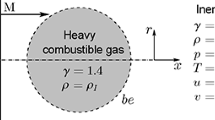Abstract
Hydrogen–oxygen chemistry is characterized by a chain branching mechanism that yields three explosion limits. While a detailed kinetic scheme appropriate for hydrogen–oxygen should produce correct results, in many circumstances, a simpler yet reasonably realistic model will be warranted. In particular, it is easier to develop a clear understanding of the reaction zone structure using a simpler model, that includes only the key mechanisms. To that effect, we consider a four-step chain branching scheme that exhibits an explosion behavior with three limits, which behaves at least qualitatively like hydrogen chemistry. We focus in particular on the structure of the initiation and chain branching zones, using a combination between numerical simulation and analysis. Numerical simulations using this chemical model show distinctive keystone figures in the flow field, close to observations in hydrogen–oxygen detonation experiments. The structure of the chain branching zone is resolved using a perturbation analysis, which clarifies the differences between explosion and no-explosion regions and allows for an evaluation of the induction length in the steady wave. The analysis assumes both high activation energy and a slow initiation. Three cases are identified, respectively, with pressure and temperature located within the explosion region, close to the explosion limit and within the no-explosion region. The induction length is shorter and the reaction rate is faster by several orders of magnitude in the explosion region.
Similar content being viewed by others
References
Tsuboi N., Katoh S., Hayashi A.K. (2002) Three-dimensional numerical simulation for hydrogen/air detonation: rectangular and diagonal structures. Proc. Combust. Inst. 29: 2783–2788
Quirk J.J. (1994) A contribution to the Great Riemann Solver Debate. Int. J. Num. Meth. Fluids 18: 555–574
Short M., Quirk J.J. (1997) On the nonlinear stability and detonability limit of a detonation wave for a model three-step chain branching reaction. J. Fluid Mech. 339: 89–119
Dainton F.S. (1965) Chain Reactions, An Introduction. Methuen, London, p. 123
Liang Z., Bauwens L.(2005) Detonation structure with pressure dependent chain branching kinetics. Proc. Combust. Inst. 30: 1879–1887
Pintgen F., Eckett C.A., Austin J.M., Shepherd J.E. (2003) Direct observations of reaction zone ztructure in propagating detonations. Combust. Flame 133(3): 211–229
Nikolic M., Williams D.N., Bauwens L. Detonation cell sizes–a numerical study. AIAA Paper 99-0967, 36th Aerospace Sciences Meeting and Exhibit (1999)
Xu S.J., Aslam T., Stewart D.S. (1997) High resolution numerical simulation of ideal and non-ideal compressible reacting flows with embedded internal boundaries. Comput. Theory Model. 1: 113–142
Buckmaster J.D., Ludford G.S.S. (1987) The effect of structure on the stability of detonations I: Role of the induction zone. Proc. Combust. Inst. 21: 1669–1676
Liang Z., Bauwens L. Detonation stability with chain branching kinetics for large activation energy. In: Proc. Spring Meeting of the CI/CS, Queen’s University, Canada, 11–14 May (2004)
Kapila A.K. (1978) Homogeneous branch-chain reactions: Initiation to completion. J. Eng. Math. 12: 221–235
Birkan M., Kassoy D.R. (1986) The unified theory for chain-branching thermal explosions with dissociation-recombination and confinement effects. Combust. Sci. Technol. 44(5–6): 223–256
Del Alamo G., Williams F.A. (2005) Thermal-runaway approximation for ignition times of branched-chain explosions. AIAA J. 43(12): 2599–2605
Author information
Authors and Affiliations
Corresponding author
Additional information
Communicated by S. Dorofeev
This paper is based on work that was presented at the 20th International Colloquium on the Dynamics of Explosions and Reactive Systems, Montreal, Canada, July 31 - August 5, 2005
Rights and permissions
About this article
Cite this article
Liang, Z., Bauwens, L. Detonation Structure Under Chain Branching Kinetics. Shock Waves 15, 247–257 (2006). https://doi.org/10.1007/s00193-006-0031-4
Received:
Accepted:
Published:
Issue Date:
DOI: https://doi.org/10.1007/s00193-006-0031-4




